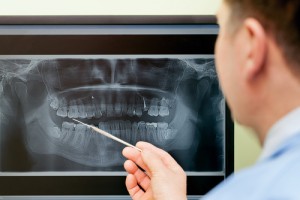8 Situations That Call For Dental X-Rays
X-rays, also known as radiographs, are common tools seen in dentist’s offices. With a growing concern regarding x-rays and radiation exposure, you may be inclined to skip this step during a dental check-up. However, it’s important to know that everyone is exposed to background radiation on a daily basis, and the amount of radiation generated by dental x-rays is minimal.
 Still, x-rays use ionizing radiation to produce images of your teeth and bones, radiation that can potentially damage the living tissue it passes through. For this reason, it’s wise to limit your exposure to dental x-rays.
Still, x-rays use ionizing radiation to produce images of your teeth and bones, radiation that can potentially damage the living tissue it passes through. For this reason, it’s wise to limit your exposure to dental x-rays.
The Food and Drug Administration and the American Dental Association establishedx-ray frequency guidelines in 2004. These guidelines are not strictly enforced, but if your dentist orders more frequent x-rays, it’s appropriate to ask if the additional x-rays will help your treatment plan. If the answer is yes, the potential dental benefits outweigh a little extra exposure to ionizing radiation.
Here are eight situations that Dr. Evanson can treat much more effectively after she sees dental x-ray images.
Permanent Teeth Development
In children, x-rays are important to determine if baby teeth are falling out quickly enough to allow permanent teeth to erupt properly. If x-rays reveal permanent teeth are developing ahead of schedule, Dr. Evanson can schedule tooth extractions to make way for healthy permanent teeth and prevent potential dental problems.
Wisdom Teeth Development
Annual x-rays help Dr. Evanson keep track of wisdom teeth development. By identifying how they are forming, she can determine if the wisdom teeth are impacted and will require surgery, or if they will erupt naturally and safely. X-rays also reveal whether there’s enough space in the mouth to keep the wisdom teeth.
Cavities
Tooth decay, which leads to cavities, can’t always be spotted with the naked eye during an oral exam. Small areas of decay between the teeth are particularly hard to spot. X-rays reveal hidden decay so you can have it treated before it grows into a worse problem.
Decay Under a Filling
If you’ve had restorative work done, decay forming beneath fillings and crowns is a constant concern. Without x-rays, problems are often left undetected until they cause you pain. Spotting and treating decay early helps you avoid worse dental problems.
Gum Disease
It’s possible to spot receding gums associated with gum disease without x-rays, but more advanced stages of the disease result in bone loss, which is undetectable with the naked eye. X-rays can reveal bone loss and allow Dr. Evanson to pursue the best treatment option possible.
Tooth or Bone Abnormalities
The bone under your gums is hidden from sight, but dangerous abnormalities caused by an infection could cause you serious pain. With x-rays to diagnose changes in the bone or root canal, your treatment plan can be much more effective.
Abscesses
An abscess is an infection inside a tooth’s root or between the gums and a tooth. When the infection begins, bacteria from the tooth can extend into the gums and cheek, beneath the tongue, into the throat, or even into the jaw bone. The condition is often very painful, but sometimes no pain is present at all. This means x-rays can be very helpful in spotting a hidden abscess and beginning treatment before the infection spreads.
Cysts and Tumors
These developmental abnormalities may or may not cause pain. They often form out of sight within the jaw, making them visible only on x-rays. Early diagnosis is important so you can begin treatment without delay.
If you have any questions or concerns about dental x-rays, or you’re ready to set up an appointment, please contact Evanson DDS online or call us at (720) 409-0008.
Leave a reply →





